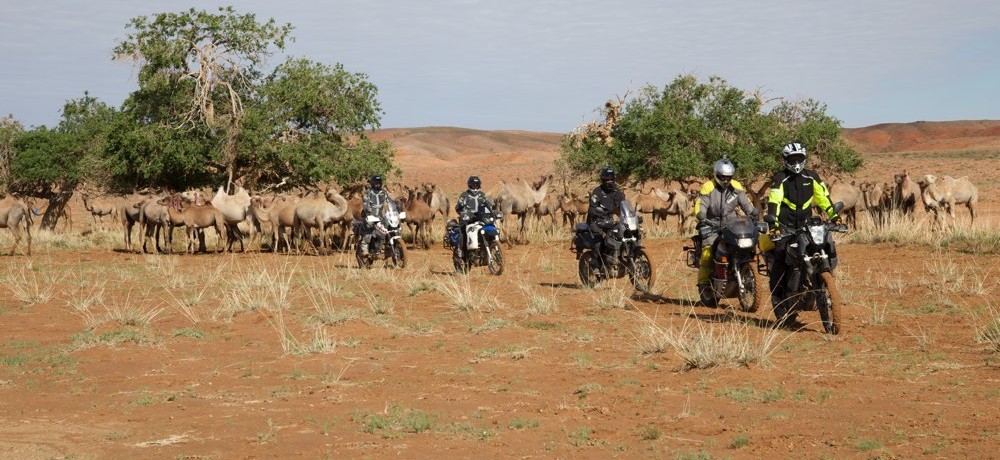Although riding in Mongolia is not for the inexperienced, it’s a wonderfully remote part of the world with friendly people, a long, rich history, and some very exciting riding
When I told people that I was going to Mongolia for a motorcycle adventure, I received two distinct responses: “Why would you want to go there?” or “That’s cool, it should be an amazing place to ride. I’m jealous.” After all, I’m sure there are very few people who have Mongolia on their list of places to visit.
I had no idea what to expect, and I have to admit, I was taken aback by the country. I only know of two people who have ridden there. One of them is Lawrence Hacking, who has competed in a couple of Mongolian rally raids (see Motorcycle Mojo, May 2015). Lawrence is perhaps the most accomplished off-road rider I know, and his response was predictable and to the point when I asked him what I can expect of the riding and the terrain. “It’s not that bad. You shouldn’t have any problem,” he said. I did take the statement with a grain of salt, considering it came from the first Canadian to finish the Paris-Dakar rally on a motorcycle.
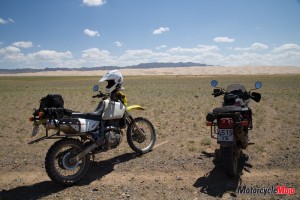 This organized Mongolian tour was put together by Rene Cormier of Renedian Adventures, a name some of you might recognize from this magazine or meeting him at motorcycle shows across the country through his business of motorcycle tours in southern Africa. Rene had organized this 2015 trip as an exploratory tour and, provided he survived, his plan was to incorporate it into his yearly schedule along with his very successful southern Africa tours. Joining Rene and me in this fact-finding mission was Darvin and Todd Puhl, Fred Lavoie, Peter Knowles, Renato Discenza and David Rea. Most of the riders arrived a day or two early to acclimatize to the 13-hour time difference and to ensure our luggage found its way. David, on the other hand, arrived at midnight the night before the ride, while his riding gear continued to fly to unknown destinations.
This organized Mongolian tour was put together by Rene Cormier of Renedian Adventures, a name some of you might recognize from this magazine or meeting him at motorcycle shows across the country through his business of motorcycle tours in southern Africa. Rene had organized this 2015 trip as an exploratory tour and, provided he survived, his plan was to incorporate it into his yearly schedule along with his very successful southern Africa tours. Joining Rene and me in this fact-finding mission was Darvin and Todd Puhl, Fred Lavoie, Peter Knowles, Renato Discenza and David Rea. Most of the riders arrived a day or two early to acclimatize to the 13-hour time difference and to ensure our luggage found its way. David, on the other hand, arrived at midnight the night before the ride, while his riding gear continued to fly to unknown destinations.
All of us have ridden in various parts of the world, but the traffic in the Mongolian capital of Ulaanbaatar (“UB” as the locals call it) caught us all by surprise. The city is progressive, but a massive influx of cars from China, Japan and Russia has made it woefully obvious that the infrastructure hasn’t kept up. Much like an odd or even house number determines lawn-watering days in a city nowadays, here a car’s licence plate number determines whether it can be on the road certain days. Even with those measures in place to reduce the mayhem, drivers take every available space on the road and make eight lanes of traffic even though only four are painted on the roadway, creating unbelievable gridlock with only millimetres between vehicles. Surprisingly, we didn’t see too many dented cars.
Drive Mongolia, the tour company Rene hired to guide us through the wilds of Mongolia under the Renedian Adventures banner, supplied a guide (Sukhee) who rode one of the bikes and was the only staffer on the trip who could speak English; a mechanic (Bataa) in a pickup with a spare bike and parts; a driver (Bayraa) in a Land Cruiser to carry luggage and the victims (more on that later); and, to everyone’s surprise, a doctor (Uuree) who accompanied us on the trip. The motorcycles consisted of a pair of Suzuki DR650s, a couple of Yamaha 660 Ténérés, two Honda Transalps, a BMW 650GS and a Suzuki 650 Freewind (similar to the 650GS). All the bikes were very well used; I left the hotel on my chosen DR650 with two bald knobbies; the front one was flat.
Exchanging Cash
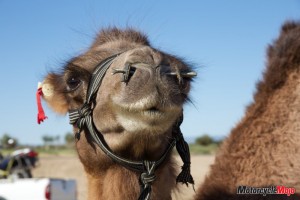 Drive Mongolia looks after all aspects of the tour, but you do need cash for fuel, beer and souvenirs. Other than stores in UB, every place else takes cash only. I went to a bank to convert American greenbacks to Mongolian tugrik and felt like a virtual millionaire. I cashed in US$500 and received 997,000 tugrik (two more dollars would have put me over one million). To put that in perspective, a beer cost 4000 to 5500 tugrik, and fuel hovered around 1900/L.
Drive Mongolia looks after all aspects of the tour, but you do need cash for fuel, beer and souvenirs. Other than stores in UB, every place else takes cash only. I went to a bank to convert American greenbacks to Mongolian tugrik and felt like a virtual millionaire. I cashed in US$500 and received 997,000 tugrik (two more dollars would have put me over one million). To put that in perspective, a beer cost 4000 to 5500 tugrik, and fuel hovered around 1900/L.
Luckily for us, we left UB on a Saturday, which meant traffic was relatively light compared to weekdays. Within an hour, we were out of the city and passing by free-range cattle at the roadside and onto our first off-pavement “road.” These roads, and I use the term very loosely, would be the introduction of what the riding would be like for the next two weeks. The circle tour began as we headed south from UB and then west once in the Gobi Desert. After a few days in the Gobi, we would travel north, and after reaching cooler temperatures, we would turn east, returning to UB 13 days later.
Rene had been through Mongolia in 2008 during his round-the-world travels as described in his book The University of Gravel Roads, but none of us, including Rene, knew what to expect on this trip, or the degree of skill needed. Information is sparse about this remote country.
Let the Carnage Begin
All eight of us had varying degrees of off-road experience, and it soon became clear that this ride wasn’t going to be a cakewalk. By lunchtime on the first day, we had our first victim of the Mongolian countryside. In Renato’s defence, he was scheduled to have a cataract removed when he returned to Canada, but the cataract basically rendered him blind in one eye, making it impossible to judge distance or contrasting shapes – like the deep rut that took him out and dislocated his left shoulder.
At the beginning of the ride we thought it odd that Drive Mongolia would supply a doctor on our trip. We soon realized the complexity of riding skills needed for the Mongolian backcountry and that a doctor might not be so bad to have around.
What Size Are Your Boots?
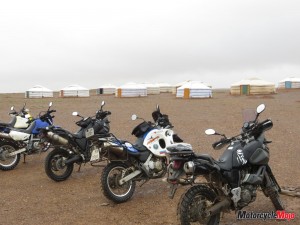 David’s riding gear was still MIA, and up to this point, he was riding shotgun with Bayraa in the Land Cruiser. Once Renato was injured, David swept in like a vulture. “Umm, we’re about the same size. What size are your boots?” And so it came to be that Renato rode shotgun and David absconded with Renato’s riding gear and his bike.
David’s riding gear was still MIA, and up to this point, he was riding shotgun with Bayraa in the Land Cruiser. Once Renato was injured, David swept in like a vulture. “Umm, we’re about the same size. What size are your boots?” And so it came to be that Renato rode shotgun and David absconded with Renato’s riding gear and his bike.
We were still adjusting to the condition of the roads, and just before arriving at our first tourist camp, we thought we ran out of road, but Sukhee just continued up a rock pass, weaving in and out of boulders. We had stopped at the top to make sure the trucks made it when a local father with his son on the back rode by on a small Chinese motorbike just wearing shorts, shirts and sandals. We must have looked like spacemen to them – all decked out in padded adventure riding gear, proper boots and helmets on dual-sport bikes.
During our travels, we often saw a motorcycle ridden by a father with kids in front and behind, or a passenger carrying a goat, and even a woman riding through a field with a baby tucked in her left arm, right hand on the throttle. Not sure how she would deal with the clutch when the time came.
Villages in Mongolia are very sparse, but luckily for Renato, we were near a hospital in Middle Gobi, which he and Uuree visited the following morning for X-rays. Total cost for an X-ray and to see the hospital’s doctor was US$15. Through translation, it was discovered that Uuree was actually an ear, nose and throat doctor. He was known thereafter as Dr. ENT. This also explained why Renato had to put his own shoulder in place after Uuree, Bataa and Sukhee had failed to do so.
The Land Cruiser Fills Up
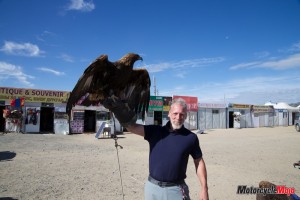 Other than a few paved highways between major centres, all the roads we travelled were two-lane tracks. A road map shows lines between villages, but the lines generally indicate that there is a path to the village and it’s up to the vehicle operator to determine which track looks the best. The tracks change regularly depending on conditions, and there could be any number of paths heading in the same direction.
Other than a few paved highways between major centres, all the roads we travelled were two-lane tracks. A road map shows lines between villages, but the lines generally indicate that there is a path to the village and it’s up to the vehicle operator to determine which track looks the best. The tracks change regularly depending on conditions, and there could be any number of paths heading in the same direction.
We ran into rain, and the resulting deep mud made for treacherous riding. A number of riders went down, but Darvin took the worst of it. He decided not to go to a hospital for X-rays, but knew he had damaged his side and shoulder. With the help of Dr. ENT’s painkillers, however, he was content to ride in the Land Cruiser with Bayraa. Not that it was a smooth ride, but he was able to hold his body tight as he was being jostled inside the truck. Two days in and we now had two riders enjoying the trip in the confines of the Land Cruiser. It was becoming painfully obvious that this terrain is not for the inexperienced rider.
Continuing south toward China, we entered the Gobi Desert and, as to be expected, plenty of sand. Almost instantly the livestock changed from cows, goats and sheep to camels, goats and sheep, and watering holes became non-existent. The staple food in Mongolia is goat and sheep, and this is what most of our meals consisted of. Camel is quite tough, and while I’ll try anything once, I probably never need to eat camel again.
What Size Are Your Boots? Part II
Renato began riding again after a day off and therefore required the riding gear he lent to David, and since David’s gear had still not arrived, Darvin volunteered his riding gear to David.
Every day brought so much diversity in the terrain and riding experience. At one point, we were on a “road” that kept crisscrossing a stream until we eventually had to ride through a crevice so skinny I didn’t think the Land Cruiser would fit. It barely squeezed through, but what amazed us was that this was an actual road – with a road sign earlier on. The high canyon walls shielded the sunlight, and snow and ice was still present on the canyon floor at the end of June. Each night of the trip we would stay at tourist camps, literally in the middle of nowhere. Most had showers – sometimes the water was even warm – and electricity from a generator at specified times for charging cameras and phones. All the camps have gers (Mongolian yurts), which we stayed in; they vary in size from about four to seven metres in diameter, and the outer walls stand about 1.5 metres high with a domed roof. The gers are tied down in the centre to the ground, or sometimes to a large rock. In one of my gers, that rock in the centre was a huge piece of petrified wood. The tourist camps’ main lodges have food and, usually, cold beer to wash down the dust. The food was typically goat or sheep with rice and a vegetable, and was generally a little bland. Everyone wished they had brought spices and hot sauce with them. Drinking Vodka Is a Favourite Pastime We were surprised by the amount of garbage we saw during the first few days. By far the bulk of the litter was vodka bottles thrown on the roadside from passing cargo trucks. We didn’t see many vehicles while traversing the wide-open countryside, but we always steered clear of them in villages for fear the operator was impaired. As the amount of litter diminished in the Gobi and beyond, the terrain continued to change. Some of it reminded us of the red boulder-type landscapes of the American Southwest, while other areas were similar to the Canadian prairies. I had heard about the steppes of Mongolia, and these vast grassy plains were the opposite of the treacherous tracks full of ruts, mud, rocks and deep sand we had become accustomed to in the previous days. They are generally high-speed plains that I was able to ride at about 120 km/h on my DR650 for several hours. By the tour’s halfway point, bikes had gone down 17 times – some had been soft landings, while others were very hard on the rider. Renato went down again for the last time this trip, as his final incident resulted in a few separated ribs and a couple of broken ones.
Different Day, Different Terrain
The riding every day presented something new and exciting and by the end of the day we couldn’t believe that we experienced so much. Leaving the Gobi Desert, we began to see watering holes again, the first of many water crossings, which were welcome considering the intense heat of the afternoons. David and his luggage were finally reacquainted just in time. Six days after Darvin was injured, he reclaimed his riding gear and began to ride again, and continued to ride until the end of the trip. He was still in pain, but he was trying to make the most of his time in Mongolia, and sitting in an SUV didn’t cut it. He picked the hardest and most technical day to ride so far, as we had to ride an extremely rough road with sharp rocks of an ancient lava field jutting out of the ground. Riding in a straight line was impossible. Later the same day we rode up grassy mountainsides, and for the first time on this trip, we saw forests and crossed too many rivers to count. It was hard to believe this was the same country, as just two days prior we saw only scrub brush and deep desert sand as fine as talcum powder. The ride up the mountain was technical, due to deep ruts and rocks, but coming down the other side was almost out of control, thanks to steep, greasy slopes. Rain had been originally forecast for this area, and had it rained on us, I’m not sure we would have been able to successfully get down the other side without damage to body or bike. After a rest day at a Russian-esque tourist camp that featured hot spring-fed pools, we had more carnage. Todd’s front tire got stuck in a rut and promptly spit him out onto his shoulder.
Unsure of his injury at the time, he continued to ride for a couple of hours until the next rest stop. I asked him if he was going to get off his bike and he painfully replied, “I don’t know if I can.” With help he got off his bike, and that was the end of his riding in Mongolia. He didn’t have the opportunity to get X-rays until a few days later in UB, but they confirmed a broken collarbone. By now Dr. ENT was running out of painkillers. On the last few days of the tour and heading in the direction of UB, the riding continued to be technical. The road took us up a number of hillsides on a path that was built out of softball- to football-sized razor-sharp rocks. Surprisingly, even though most of the tires were bald, no one had a sliced tire. That was followed by a couple of hours on a paved highway with so many potholes that cars and trucks were driving in the ditches. Final Thoughts We all went to Mongolia knowing full well this was an exploratory adventure in one of the most remote regions on the planet. Little information was available on what we could expect, and the unknown was just one of the aspects that made this trip so exciting.
Personally, I loved every part of it and would return at a moment’s notice given the opportunity. The country is still quite primitive in many ways, although the city of UB is progressive. Safety, as we know it in our litigious, nanny-state society, doesn’t exist. Always be aware that common sense and riding within your limits is your best line of defence. Darvin, by the way, did go to see a doctor when he returned to Canada, and X-rays showed he had four cracked ribs and a cracked scapula. It takes a certain hard-core toughness to ride injured, and my hat is off to Renato, Darvin and Todd. In total, out of five riders, a bike went down 21 times during 12 riding days. Next year’s sold-out Mongolian tour through Renedian Adventures (renedian.com) will be another exploratory trip with a different tour operator, different bikes and a different route. Rene will then decide which company he will use in the future. Riding in Mongolia is rough around the edges and an adventure, to say the least.
Everyone we met and the staff at the tourist camps were very friendly. The accommodation and food are good, the scenery is amazing, and the riding is technical and recommended only for the experienced off-road rider. And one thing is for sure: we all left the land of Genghis Khan far better riders than when we arrived. Genghis Khan is revered as a national hero and the founder of Mongolia as we know it today. Although today his title graces everything from the main square in Ulaanbaatar to road signs to statues, Genghis Khan was a military genius with a merciless brutal side. Born in 1162, Temujin (the Mongol chieftain’s name) began amassing an army of 20,000 men by age 20, and in 1206, at the age of 44, he was in control of central and eastern Mongolia. It was around this time he was given the title Genghis Khan (properly spelled Chinggis Khaan in Mongolian), meaning “Universal Ruler,” and it was deemed by the leading shaman that he was the representative of the Supreme God of the Mongols.
Genghis Khan felt it was his destiny to rule the world. And he might have, had he lived long enough. With his defeating of neighbouring empires and dynasties, the Mongol-claimed land continued to grow. By the time he died, Genghis Khan had conquered more than twice as much land as any other person in history. His enemies could either surrender or be killed. It’s impossible to know the exact number, but it’s estimated that more than 40 million people died as he waged war and grew his empire. At the time of his death in 1227, the Mongolian Empire covered nearly 24 million square kilometres, about four times the size of the Roman or Macedonian Empires. Genghis Khan’s sons and grandsons continued to assimilate foreign lands until 1368, when the empire was overthrown by the Ming Dynasty. At the height of the Mongolian Empire, Mongols ruled most of modern-day Russia, China, Korea, Southeast Asia, Iran, India, the Middle East and eastern Europe. Things to Bring It can be very dusty and dry so it’s important to keep hydrated.
The tour company always had bottles of water on hand. I found off-road goggles very helpful to fend off the dust while full-face helmets allow dust to get into your eyes. You might also want to bring lip balm, good eye drops and nasal spray. Sunscreen and a shade hat to keep the sun at bay is important as the sun is very hot in the daytime. It can get chilly in the desert at night so a fleece and toque might be helpful. A headlight is very handy. A bottle or two of your favourite spice and hot sauce will go along way, and everyone in your group will be your best friend.









